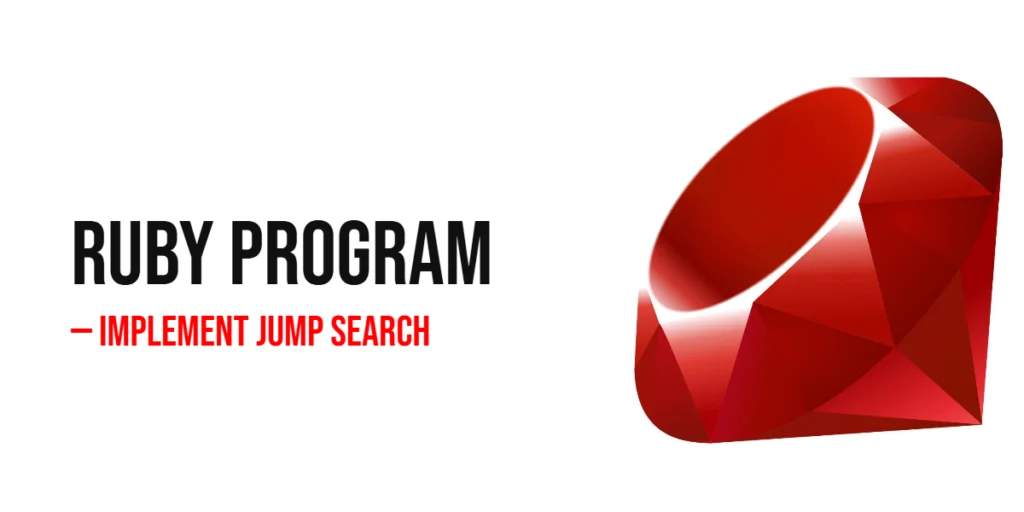Searching through data efficiently is a fundamental part of programming, especially when working with large sorted datasets. One algorithm that balances simplicity and efficiency is Jump Search. Jump Search works by checking elements at fixed intervals or “jumps” instead of checking every single element. Once the search overshoots the target, it performs a linear search within that block, combining the best of both worlds: faster skipping like Binary Search, and simple linear checking within a smaller range.

with hands-on learning.
get the skills and confidence to land your next move.
Jump Search is particularly useful for sorted datasets where accessing elements sequentially is expensive, such as in large arrays or data stored on external storage. For beginners, learning Jump Search in Ruby helps understand the idea of block-wise searching and improving search efficiency without complex logic. In this article, we will cover multiple ways to implement Jump Search, including iterative and recursive approaches, making it beginner-friendly and practical.
Program 1: Iterative Jump Search
This program demonstrates Jump Search using a simple iterative approach with a predefined block size to find a target number in a sorted array.
# Program 1: Iterative Jump Search
def jump_search(array, target)
n = array.length
step = Math.sqrt(n).to_i
prev = 0
while array[[step, n].min - 1] < target
prev = step
step += Math.sqrt(n).to_i
return -1 if prev >= n
end
(prev...[step, n].min).each do |i|
return i if array[i] == target
end
-1
end
numbers = [1, 3, 5, 7, 9, 11, 13, 15, 17, 19]
target = 11
index = jump_search(numbers, target)
if index != -1
puts "Element #{target} found at index #{index}"
else
puts "Element #{target} not found"
endIn this example, the search jumps ahead by sqrt(n) positions to quickly narrow the potential block where the target resides. After overshooting, it performs a linear search in the identified block. Beginners can see how combining jumps and linear checks reduces the total comparisons compared to a standard linear search.
Program 2: Jump Search Using While Loop
Another iterative approach uses a while loop for both jumping and block searching, showing an alternative way to control the flow.
# Program 2: Jump Search using while loop
def jump_search_while(array, target)
n = array.length
step = Math.sqrt(n).to_i
prev = 0
# Jump through blocks until we find the possible block
while prev < n && array[[prev + step, n].min - 1] < target
prev += step
return -1 if prev >= n
end
# Linear search within the found block
while prev < [prev + step, n].min
return prev if array[prev] == target
prev += 1
end
-1
end
numbers = [2, 4, 6, 8, 10, 12, 14, 16]
target = 10
index = jump_search_while(numbers, target)
if index != -1
puts "Element #{target} found at index #{index} (while loop)"
else
puts "Element #{target} not found (while loop)"
endThis approach emphasizes the use of controlled while loops for both jumping and linear block search. Beginners can practice using ranges and loops effectively in Ruby while understanding the mechanics of Jump Search.
Program 3: Jump Search for Floating-Point Numbers
Jump Search can also handle floating-point numbers in sorted arrays, making it versatile for numerical datasets.
# Program 3: Jump Search with floating-point numbers
def jump_search(array, target)
n = array.length
step = Math.sqrt(n).to_i
prev = 0
while array[[step, n].min - 1] < target
prev = step
step += Math.sqrt(n).to_i
return -1 if prev >= n
end
(prev...[step, n].min).each do |i|
return i if array[i] == target
end
-1
end
numbers = [0.5, 1.2, 2.3, 3.7, 4.6, 5.5, 6.8]
target = 3.7
index = jump_search(numbers, target)
if index != -1
puts "Floating-point element #{target} found at index #{index}"
else
puts "Floating-point element #{target} not found"
endSince Jump Search only relies on comparisons and array access, it works naturally with floats. Beginners can see that the algorithm is flexible and not limited to integers.
Program 4: Jump Search on Large Datasets
This program demonstrates Jump Search on a larger array, showing its efficiency compared to Linear Search for sorted, sizable datasets.
# Program 4: Jump Search on large dataset
def jump_search(array, target)
n = array.length
step = Math.sqrt(n).to_i
prev = 0
while array[[step, n].min - 1] < target
prev = step
step += Math.sqrt(n).to_i
return -1 if prev >= n
end
(prev...[step, n].min).each do |i|
return i if array[i] == target
end
-1
end
numbers = (1..1000).to_a
target = 678
index = jump_search(numbers, target)
if index != -1
puts "Element #{target} found at index #{index} in large dataset"
else
puts "Element #{target} not found in large dataset"
endHere, the jumps quickly narrow down the block containing the target, making it much faster than scanning all 1000 elements linearly. Beginners can appreciate the efficiency gain by practicing with large arrays.
Frequently Asked Questions (FAQ)
Jump Search is new to many beginners, so here are some common questions:
Q1: What is the time complexity of Jump Search?
Jump Search has a time complexity of O(√n), making it faster than Linear Search for large datasets.
Q2: Can Jump Search work on unsorted arrays?
No, the array must be sorted for Jump Search to work correctly.
Q3: How is the optimal jump size determined?
The optimal jump size is generally √n, where n is the size of the array, to balance jumps and linear searches.
Q4: Can Jump Search handle floating-point numbers?
Yes, as long as the array is sorted and comparisons are supported, floats can be searched.
Q5: Is Jump Search better than Binary Search?
For very large datasets, Binary Search is usually faster due to logarithmic complexity. Jump Search is simpler and may be useful in sequential-access environments.
Conclusion
In this article, we explored how to implement Jump Search in Ruby using iterative approaches, handling floating-point numbers, and searching efficiently in large datasets. Jump Search combines the simplicity of linear search with the speed of block-wise skipping, making it a practical algorithm for sorted arrays. By practicing these examples, beginners can understand the concept of jumping, block searching, and how to optimize search operations. Mastering Jump Search adds another tool to a beginner’s programming toolkit and builds a foundation for understanding advanced search algorithms.







